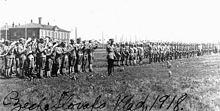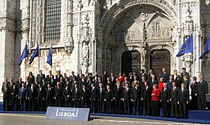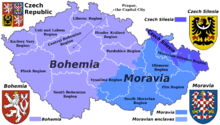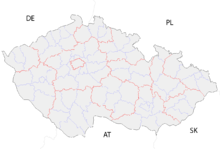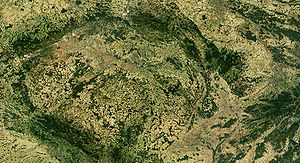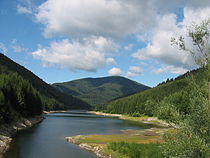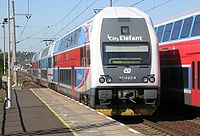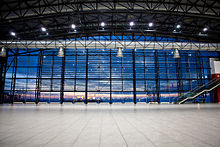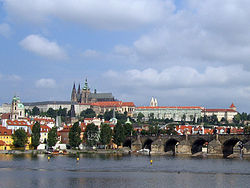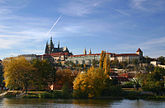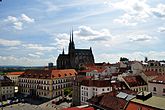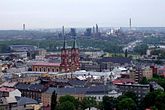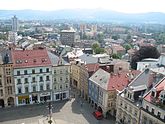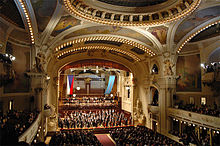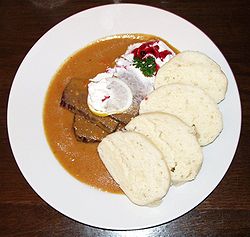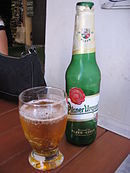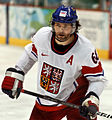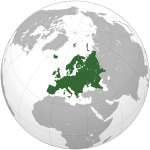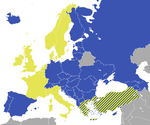- Czech Republic
-
This article is about the country in Europe. For other uses, see Czech Republic (disambiguation).
Czech Republic Česká republika

Flag Coat of arms Motto: "Pravda vítězí" (Czech)
"Truth prevails"Anthem: Kde domov můj? (Czech)
"Where is my home?"[a]Location of Czech Republic (dark green)– in Europe (green & dark grey)
– in the European Union (green) — [Legend]Capital
(and largest city)Prague (Praha)
50°05′N 14°28′E / 50.083°N 14.467°EOfficial language(s) Czech, Slovak[1] Officially recognized
minority languagesBulgarian, Croatian, German, Greek, Hungarian, Polish, Romani, Russian, Rusyn, Serbian and Ukrainian[2] Ethnic groups (2001) 90.5% Czechs,
3.7% Moravians,
1.9% Slovaks,
3.9% others and unspecified[3]Demonym Czech Government Parliamentary republic - President Václav Klaus - Prime Minister Petr Nečas Formation - Principality of Bohemia c. 870 - Kingdom of Bohemia 1198 - Czechoslovakia 28 October 1918 - Czech Republic 1 January 1993 Area - Total 78,866 km2 (116th)
30,450 sq mi- Water (%) 2 Population - 2011 estimate 10,535,811[4] (78th) - 2001 census 10,230,060 - Density 133/km2 (84th)
341/sq miGDP (PPP) 2010 (CIA World Factbook) estimate - Total $261.3 billion - Per capita $25,600 GDP (nominal) 2010 estimate - Total $192.152 billion[5] - Per capita $18,288[5] Gini (2008) 26 (low) (4th) HDI (2010)  0.841[6] (very high) (28th)
0.841[6] (very high) (28th)Currency Czech koruna ( CZK)Time zone CET (UTC+1) - Summer (DST) CEST (UTC+2) Drives on the right ISO 3166 code CZ Internet TLD .cz³ Calling code +4204 1 30 June 2010 (See Population changes). 2 Rank based on 2009 IMF data. 3 Also .eu, shared with other European Union member states. 4 Shared code 42 with Slovakia until 1997.
^ a. Rhetorical question meaning "Those places where my homeland lies".The Czech Republic (
 i/ˈtʃɛk/ chek;[7] Czech: Česká republika, pronounced [ˈtʃɛskaː ˈrɛpuˌblɪka] (
i/ˈtʃɛk/ chek;[7] Czech: Česká republika, pronounced [ˈtʃɛskaː ˈrɛpuˌblɪka] ( listen), short form Česko [ˈtʃɛskɔ]) is a landlocked country in Central Europe. The country is bordered by Poland to the northeast, Slovakia to the east, Austria to the south, and Germany to the west and northwest.
listen), short form Česko [ˈtʃɛskɔ]) is a landlocked country in Central Europe. The country is bordered by Poland to the northeast, Slovakia to the east, Austria to the south, and Germany to the west and northwest.It is a pluralist multi-party parliamentary representative democracy, a member of the European Union, NATO, the OECD, the OSCE, the Council of Europe and the Visegrád Group.
The Czech state, formerly known as Bohemia, was formed in the late 9th century as a small duchy around Prague, at that time under dominance of the powerful Great Moravian Empire (which reached its greatest territorial extent during the reign of Svatopluk I from the House of Mojmír). After the fall of the Empire in 907, the centre of power was transferred from Moravia to Bohemia, under the Přemyslids. During the rule of Přemyslid dukes/kings and their successors, the Luxembourgs, the country reached its greatest territorial extent (13th–14th century). Life in the country was significantly affected by the Hussite wars, during which it faced economic embargo and crusades from all over Europe. Following the Battle of Mohács in 1526, the Crown of Bohemia was gradually integrated into the Habsburg monarchy as one of its three principal parts alongside the Archduchy of Austria and the Kingdom of Hungary. The Bohemian Revolt (1618–20) led to the further centralization of the monarchy including forced recatholization and Germanization. During radical reforms in the 18th century the Bohemian Crown was even de facto abolished (1749). In the 19th century the Czech lands became the industrial powerhouse of the monarchy and the core of the Republic of Czechoslovakia which was formed in 1918, following the collapse of the Austro-Hungarian empire after World War I.
After the Munich Agreement, Polish annexation of Zaolzie and German occupation of Czechoslovakia and the consequent disillusion with the Western response and gratitude for the liberation of the major portion of Czechoslovakia by the Red Army, the Communist Party of Czechoslovakia won the plurality in the 1946 elections. In a 1948 coup d'état, Czechoslovakia became a communist-ruled state. In 1968, the increasing dissatisfaction culminated in attempts to reform the communist regime. The events, known as the Prague Spring of 1968, ended with an invasion by the armies of the Warsaw Pact countries (with the exception of Romania); the troops remained in the country until the 1989 Velvet Revolution, when the communist regime collapsed. On 1 January 1993, Czechoslovakia peacefully dissolved into its constituent states, the Czech Republic and the Slovak Republic.
The Czech Republic is the first former member of the Comecon to achieve the status of a developed country according to the World Bank.[8] In addition, the country has the highest human development in Central and Eastern Europe,[9] ranking as a "Very High Human Development" nation. It is also ranked as the third most peaceful country in Europe[10] and most democratic and healthy (by infant mortality) country in the region[11][12].
Contents
Etymology
Main article: Name of the Czech RepublicThe traditional English name "Bohemia" derives from Latin "Boiohaemum", which means "home of the Boii". The current name comes from the Czech endonym Čechy using the antiquated spelling Czechy, identical to the Polish spelling.[13]
The country has been traditionally divided into lands, namely Bohemia proper (Čechy) in the west, Moravia (Morava) in the southeast, and Czech Silesia (Slezsko; the smaller, south-eastern part of historical Silesia, most of which is located within modern Poland) in the northeast. Known officially as the "Crown of the Kingdom of Bohemia" since the 14th century, a number of other names of the country had been used, including the Lands of the Bohemian Crown, Czech/Bohemian lands, Bohemian Crown, Lands of the Crown of Saint Wenceslas etc. When the country regained its independence after the dissolution of the Austro-Hungarian empire in 1918, the new name of Czechoslovakia was coined to reflect the union of the Czech and Slovak nations within the new country.
Following the dissolution of Czechoslovakia at the end of 1992, the Czech part of the former nation found itself without a common single-word name in English. In 1993, the Czech Ministry of Foreign Affairs suggested the name Czechia /ˈtʃɛkiə/ (Česko [ˈtʃɛskɔ] in Czech) as an official alternative in all situations other than formal official documents and the full names of government institutions; however, this has not become widespread in English, even though most other languages have single-word names for the country (usually their own variants of "Czechia").
History
Main article: History of the Czech landsPrehistory
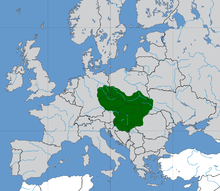 Great Moravia during the reign of Svatopluk I
Great Moravia during the reign of Svatopluk I
Archaeologists have found evidence of prehistoric human settlements in the area, dating back to the Neolithic era. In the classical era, from the 3rd century BC Celtic migrations, the Boii and later in the 1st century, Germanic tribes of Marcomanni and Quadi settled there. During the Migration Period around the 5th century, many Germanic tribes moved westwards and southwards out of Central Europe.
Slavic people from the Black Sea and Carpathian regions settled in the area (a movement that was also stimulated by the onslaught of peoples from Siberia and Eastern Europe: Huns, Avars, Bulgars and Magyars). Following in the Germans' wake, they moved southwards into Bohemia, Moravia and some of present day Austria. During the 7th century, the Frankish merchant Samo, supporting the Slavs fighting their Avar rulers, became the ruler of the first known Slav state in Central Europe. The Moravian principality arose in the 8th century.
Bohemia
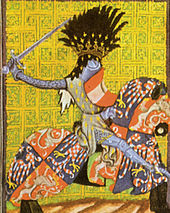 Přemysl Ottokar II, (c. 1233–1278), King of Bohemia and ruler of Austria, Styria, Carinthia and Carniola
Přemysl Ottokar II, (c. 1233–1278), King of Bohemia and ruler of Austria, Styria, Carinthia and Carniola
The Bohemian or Czech state emerged in the late 9th century, when it was unified by the Přemyslid dynasty. The Kingdom of Bohemia was, as the only kingdom in the Holy Roman Empire, a significant regional power during the Middle Ages. It was part of the Empire from 1002 till 1804, with the exception of years 1440–1526.
In 1212, King Přemysl Otakar I, bearing the title "king" since 1198, extracted a Golden Bull of Sicily (a formal edict) from the emperor, confirming the royal title for Otakar and his descendants. Large-scale German immigration occurred in the 13th century. The Germans populated towns and mining districts on the Bohemian periphery and, in some cases, formed German colonies in the interior of the Czech lands. In 1235, the mighty Mongol army launched an invasion of Europe. After the Battle of Legnica, the Mongols carried their devastating raid into Moravia, but they were beaten by the Czech royal army in a battle of Olomouc and continued into Hungarian lands.[14]
King Přemysl Otakar II earned the nickname "Iron and Golden King" because of his military power and wealth. He acquired Austria, Styria, Carinthia and Carniola, thus spreading the Bohemian territory to the Adriatic Sea. He met his death at the Battle on the Marchfeld in 1278 in a war with his rival, King Rudolph I of Germany.[15] Ottokar's son Wenceslaus II acquired the Polish crown in 1300 for himself and the Hungarian crown for his son. He built a great empire stretching from the Danube river to the Baltic Sea. In 1306, the last king of Přemyslid line was murdered in mysterious circumstances in Olomouc while he was resting. After a series of dynastic wars, the House of Luxembourg gained the Bohemian throne.[16]
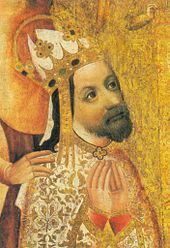 Charles IV, 1316–78, eleventh king of Bohemia, elected as the Největší Čech (Greatest Czech) of all time.[17]
Charles IV, 1316–78, eleventh king of Bohemia, elected as the Největší Čech (Greatest Czech) of all time.[17]
The 14th century, particularly the reign of Czech King Charles IV, who became also King of Italy, King of the Romans and Holy Roman Emperor, is considered the Golden Age of Czech history. Of particular significance was the founding of Charles University in Prague in 1348, Charles Bridge, Charles Square and were completed much of the Prague Castle and cathedral of Saint Vitus. The Black Death, which had raged in Europe from 1347 to 1352, decimated the Kingdom of Bohemia in 1380,[18] killing about 10% of the population.[19]
In the 15th century, the religious and social reformer Jan Hus formed a movement later named after him. Although Hus was named a heretic and burnt in Constanz in 1415, his followers seceded from the Catholic Church and in the Hussite Wars (1419–1434) defeated five crusades organized against them by the Holy Roman Emperor Sigismund. Petr Chelčický continued with Czech Hussite Reformation movement. During the next two centuries, 90% of the inhabitants became adherents of the Hussite Christian movement.
After 1526 Bohemia came increasingly under Habsburg control as the Habsburgs became first the elected and then the hereditary rulers of Bohemia. The Defenestration of Prague and subsequent revolt against the Habsburgs in 1618 marked the start of the Thirty Years' War, which quickly spread throughout Central Europe. In 1620, the rebellion in Bohemia was crushed at the Battle of White Mountain, and the ties between Bohemia and Habsburgs' hereditary lands in Austria were strengthened. The war had a devastating effect on the local population; the people were given the choice either to convert to Catholicism or leave the country.
The following period, from 1620 to the late 18th century, has been often called the "Dark Age". The population of the Czech lands declined by a third through war, disease, famine and the expulsion of the Protestant Czechs.[20] The Habsburgs banned all religions other than Catholicism.[21] Ottoman Turks and Tatars invaded Moravia in 1663.[22] In 1679–1680 the Czech lands faced a devastating plague and an uprising of serfs.[23]
The reigns of Maria Theresa of Austria and her son Joseph II, Holy Roman Emperor and co-regent from 1765, were characterized by enlightened absolutism. In 1742, most of Silesia, then the possession of the Bohemian crown, was seized by King Frederick II of Prussia in the War of the Austrian Succession. The Great Famine, which lasted from 1770 until 1771, killed about one tenth of the Czech population, or 250,000 inhabitants, and radicalized countrysides leading to peasant uprisings.[24]
After the fall of the Holy Roman Empire, Bohemia became part of the Austrian Empire and later of Austria–Hungary. Serfdom was not completely abolished until 1848. After the Revolutions of 1848, Emperor Franz Josef I of Austria instituted an absolute monarch in an effort to balance competing ethnic interests in the empire.
Czechoslovakia
Main article: History of CzechoslovakiaAn estimated 1.4 million Czech soldiers fought in in World War I, of them some 150,000 died. More than 90,000 Czech volunteers formed the Czechoslovak Legions in France, Italy and Russia, where they fought against the Central Powers and later against Bolshevik troops.[25] Following the collapse of the Austro-Hungarian Empire after World War I, the independent republic of Czechoslovakia was created in 1918. This new country incorporated the Bohemian Crown (Bohemia, Moravia and Silesia) and parts of the Kingdom of Hungary (Slovakia and the Carpathian Ruthenia) with significant German, Hungarian, Polish and Ruthenian speaking minorities.[26]
Although Czechoslovakia was a unitary state, it provided what were at the time rather extensive rights to its minorities and remained the only democracy in this part of Europe in the interwar period. The effects of the Great Depression including high unemployment and massive propaganda from Nazi Germany, however, resulted in discontent and strong support among ethnic Germans for a break from Czechoslovakia. Adolf Hitler took advantage of this opportunity and, using Konrad Henlein's separatist Sudeten German Party, gained the largely German speaking Sudetenland (and its substantial Maginot Line like border fortifications) through the 1938 Munich Agreement (signed by Nazi Germany, France, Britain and Italy), despite the mobilization of 1.2 million-strong Czechoslovak army and the Franco-Czech military alliance. Poland annexed the Zaolzie area around Český Těšín. Hungary gained parts of Slovakia and the Subcarpathian Rus as a result of the First Vienna Award in November 1938.
The remainders of Slovakia and the Subcarpathian Rus gained greater autonomy, with the state renamed to "Czecho-Slovakia". After Nazi Germany threatened to annex part of Slovakia, allowing the remaining regions to be partitioned by Hungary and Poland, Slovakia chose to maintain its national and territorial integrity, seceding from Czecho-Slovakia in March 1939, and allying itself, as demanded by Germany, with Hitler's coalition.[27]
The remaining Czech territory was occupied by Germany, which transformed it into the so-called Protectorate of Bohemia and Moravia. The protectorate was proclaimed part of the Third Reich, and the president and prime minister were subordinate to the Nazi Reichsprotektor ("imperial protector"). Subcarpathian Rus declared independence as the Republic of Carpatho-Ukraine on 15 March 1939 but was invaded by Hungary the same day and formally annexed the next day. Approximately 345,000 Czechoslovak citizens, including 277,000 Jews, were killed or executed while hundreds of thousands of others were sent to prisons and concentration camps or used as forced labour. Perhaps two–thirds of the Czech nation was destined either for extermination or removal.[28] A Nazi concentration camp existed at Terezín, north of Prague.
A memorial to 82 Lidice children murdered by the Nazis in Chelmno.
There was Czech resistance to Nazi occupation, both at home and abroad, most notably with the assassination of Nazi leader Reinhard Heydrich in a Prague suburb on 27 May 1942. The Czechoslovak government-in-exile and its army fighting against the Germans were acknowledged by the Allies; Czech/Czechoslovak troops fought from the very beginning of the war in Poland, France, the UK, North Africa, the Middle East and the Soviet Union. The German occupation ended on 9 May 1945, with the arrival of the Soviet and American armies and the Prague uprising. An estimated 140,000 Soviet soldiers died in conquering Czechoslovakia from German rule.[29]
In 1945–1946, almost the entire German minority in Czechoslovakia, about 3 million people, were expelled to Germany and Austria. During this time, thousands of Germans were held in prisons and detention camps or used as forced labour. In the summer of 1945, there were several massacres. The only Germans not expelled were some 250,000 who had been active in the resistance against the Nazis or were considered economically important, though many of these emigrated later. Following a Soviet-organised referendum, the Subcarpathian Rus never returned under Czechoslovak rule but became part of the Ukrainian Soviet Socialist Republic, as the Zakarpattia Oblast in 1946.
Czechoslovakia uneasily tried to play the role of a "bridge" between the West and East. However, the Communist Party of Czechoslovakia rapidly increased in popularity, with a general disillusionment with the West, because of the pre-war Munich Agreement, and a favourable popular attitude towards the Soviet Union, because of the Soviets' role in liberating Czechoslovakia from German rule. In the 1946 elections, the Communists gained 38%[30] of the votes and became the largest party in the Czechoslovak parliament. They formed a coalition government with other parties of the National Front and moved quickly to consolidate power. The decisive step took place in February 1948, during a series of events characterized by Communists as a "revolution" and by anti-Communists as a "takeover", the Communist People's Militias secured control of key locations in Prague, and a new all-Communist government was formed.
For the next 41 years, Czechoslovakia was a Communist state within the Eastern Bloc. This period is characterized by lagging behind the West in almost every aspect of social and economic development. The country's GDP per capita fell from the level of neighboring Austria below that of Greece or Portugal in the 1980s. The Communist government completely nationalized the means of production and established a command economy. The economy grew rapidly during the 1950s but slowed down in the 1960s and 1970s and stagnated in the 1980s. The political climate was highly repressive during the 1950s, including numerous show trials and hundreds of thousands of political prisoners, but became more open and tolerant in the late 1960s, culminating in Alexander Dubček's leadership in the 1968 Prague Spring, which tried to create "socialism with a human face" and perhaps even introduce political pluralism. This was forcibly ended by 21 August 1968 Warsaw Pact invasion.
The invasion was followed by a harsh program of "Normalization" in the late 1960s and the 1970s. Until 1989, the political establishment relied on censorship of the opposition. Dissidents published Charter 77 in 1977, and the first of a new wave of protests were seen in 1988. Between 1948 and 1989 more than 250,000 Czechs and Slovaks were sent to prison for "anti-state activities" and over 400,000 emigrated.[31]
Velvet revolution and independence
In November 1989, Czechoslovakia returned to a liberal democracy through the peaceful "Velvet Revolution". However, Slovak national aspirations strengthened and on 1 January 1993, the country peacefully split into the independent Czech Republic and Slovakia. Both countries went through economic reforms and privatisations, with the intention of creating a capitalist economy. This process was largely successful; in 2006 the Czech Republic was recognised by the World Bank as a "developed country",[8] and in 2009 the Human Development Index ranked it as a nation of "Very High Human Development".[9]
From 1991, the Czech Republic, originally as part of Czechoslovakia and now in its own right, has been a member of the Visegrád Group and from 1995, the OECD. The Czech Republic joined NATO on 12 March 1999 and the European Union on 1 May 2004. It held the Presidency of the European Union for the first half of 2009.
Politics
Main article: Politics of the Czech Republic Václav Havel, the first President of the Czech Republic.
Václav Havel, the first President of the Czech Republic.
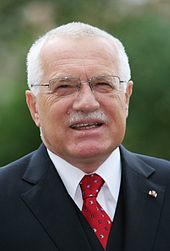 Václav Klaus, current President of the Czech Republic.
Václav Klaus, current President of the Czech Republic.
The Czech Republic is a pluralist multi-party parliamentary representative democracy, with the Prime Minister as head of government. The Parliament (Parlament České republiky) is bicameral, with the Chamber of Deputies (Czech: Poslanecká sněmovna) (200 members) and the Senate (Czech: Senát) (81 members).
The President of the Czech Republic is selected by a joint session of the parliament for a five-year term, with no more than two consecutive terms. The president is a formal head of state with limited specific powers, most importantly to return bills to the parliament, nominate Constitutional court judges for the Senate's approval and dissolve the parliament under certain special and unusual circumstances. He also appoints the prime minister, as well the other members of the cabinet on a proposal by the prime minister.
The Prime Minister is the head of government and wields considerable powers, including the right to set the agenda for most foreign and domestic policy, mobilize the parliamentary majority and choose government ministers.
The members of the Chamber of Deputies are elected for a four year term by proportional representation, with a 5% election threshold. There are 14 voting districts, identical to the country's administrative regions. The Chamber of Deputies, the successor to the Czech National Council, has the powers and responsibilities of the now defunct federal parliament of the former Czechoslovakia.
The members of the Senate are elected in single-seat constituencies by two-round runoff voting for a six-year term, with one-third elected every even year in the autumn. The first election was in 1996, for differing terms. This arrangement is modeled on the U.S. Senate, but each constituency is roughly the same size and the voting system used is a two-round runoff. The Senate is unpopular among the public and suffers from low election turnout, overall roughly 30% in the first round and 20% in the second.
Foreign relations
Main article: Foreign relations of the Czech RepublicMembership in the European Union is central in Czech Republic's foreign policy. The Czech Republic held the Presidency of the Council of the European Union for the first half of 2009.
Czech officials have[vague] supported dissenters in Burma, Belarus, Moldova and Cuba.[32]
 Czech soldier in Afghanistan
Czech soldier in Afghanistan
Military
Main article: Military of the Czech RepublicThe Czech armed forces consist of the Army, Air Force and of specialized support units. The president of the Czech Republic, currently Václav Klaus, is Commander-in-Chief of the armed forces. In 2004 the army transformed itself into a fully professional organization and compulsory military service was abolished. The country has been a member of NATO since 12 March 1999. Defence spending is around 1.8% of the GDP (2006). Currently, as a member of NATO, the Czech military are participating in ISAF and KFOR operations and have soldiers in Afghanistan and Kosovo. Main equipment includes: multirole fighters JAS-39 Gripen, combat aircraft Aero L-159 Alca, attack helicopters Mi-24, armoured vehicles Pandur II, OT-64, OT-90, BVP-2 and Czech modernized tanks T-72 (T-72M4CZ). Main foreign industry suppliers are Russia, the United States and Germany.
Administrative divisions
See also: Regions of the Czech Republic and Districts of the Czech RepublicSince 2000, the Czech Republic is divided into thirteen regions (Czech: kraje, singular kraj) and the capital city of Prague. Each region has its own elected Regional Assembly (krajské zastupitelstvo) and hejtman (usually translated as hetman or "president"). In Prague, their powers are executed by the city council and the mayor.
The older seventy-six districts (okresy, singular okres) including three "statutory cities" (without Prague, which had special status) lost most of their importance in 1999 in an administrative reform; they remain as territorial divisions and seats of various branches of state administration.[33]
(Lic. plate) Region Capital Population (2004 est.) Population (2010 est.) A  Prague, the Capital City (Hlavní město Praha)
Prague, the Capital City (Hlavní město Praha)1,170,571 1,251,072 S  Central Bohemian Region (Středočeský kraj)
Central Bohemian Region (Středočeský kraj)offices located in Prague (Praha) 1,144,071 1,256,850 C  South Bohemian Region (Jihočeský kraj)
South Bohemian Region (Jihočeský kraj)České Budějovice 625,712 637,723 P  Plzeň Region (Plzeňský kraj)
Plzeň Region (Plzeňský kraj)Plzeň 549,618 571,831 K  Karlovy Vary Region (Karlovarský kraj)
Karlovy Vary Region (Karlovarský kraj)Karlovy Vary 304,588 307,380 U  Ústí nad Labem Region (Ústecký kraj)
Ústí nad Labem Region (Ústecký kraj)Ústí nad Labem 822,133 835,814 L  Liberec Region (Liberecký kraj)
Liberec Region (Liberecký kraj)Liberec 427,563 439,458 H  Hradec Králové Region (Královéhradecký kraj)
Hradec Králové Region (Královéhradecký kraj)Hradec Králové 547,296 554,370 E  Pardubice Region (Pardubický kraj)
Pardubice Region (Pardubický kraj)Pardubice 505,285 516,777 M  Olomouc Region (Olomoucký kraj)
Olomouc Region (Olomoucký kraj)Olomouc 635,126 641,555 T  Moravian-Silesian Region (Moravskoslezský kraj)
Moravian-Silesian Region (Moravskoslezský kraj)Ostrava 1,257,554 1,244,837 B  South Moravian Region (Jihomoravský kraj)
South Moravian Region (Jihomoravský kraj)Brno 1,123,201 1,152,819 Z  Zlín Region (Zlínský kraj)
Zlín Region (Zlínský kraj)Zlín 590,706 590,527 J  Vysočina Region (Kraj Vysočina)
Vysočina Region (Kraj Vysočina)Jihlava 517,153 514,805 Geography
See also: Geography of the Czech Republic and Protected Areas of the Czech RepublicThe Czech Republic lies mostly between latitudes 48° and 51° N (a small area lies north of 51°), and longitudes 12° and 19° E.
The Czech landscape is exceedingly varied. Bohemia, to the west, consists of a basin drained by the Elbe (Czech: Labe) and the Vltava (or Moldau) rivers, surrounded by mostly low mountains, such as the Krkonoše range of the Sudetes. The highest point in the country, Sněžka at 1,602 m (5,256 ft), is located here. Moravia, the eastern part of the country, is also quite hilly. It is drained mainly by the Morava River, but it also contains the source of the Oder River (Czech: Odra).
Water from the landlocked Czech Republic flows to three different seas: the North Sea, Baltic Sea and Black Sea. The Czech Republic also leases the Moldauhafen, a 30,000-square-metre (7.4-acre) lot in the middle of the Hamburg Docks, which was awarded to Czechoslovakia by Article 363 of the Treaty of Versailles, to allow the landlocked country a place where goods transported down river could be transferred to seagoing ships. The territory reverts to Germany in 2028.
Phytogeographically, the Czech Republic belongs to the Central European province of the Circumboreal Region, within the Boreal Kingdom. According to the World Wide Fund for Nature, the territory of the Czech Republic can be subdivided into four ecoregions: the Central European mixed forests, Pannonian mixed forests, Western European broadleaf forests and Carpathian montane conifer forests.
There are four national parks in the Czech Republic. The oldest is Krkonoše National Park (Biosphere Reserve), Šumava National Park (Biosphere Reserve), National Park Podyjí, České Švýcarsko National Park.
Climate
The Czech Republic has a temperate continental climate, with relatively hot summers and cold, cloudy and snowy winters. Most rain falls during the summer. The temperature difference between summer and winter is relatively high, due to the landlocked geographical position.[34]
Within the Czech Republic, temperatures vary greatly, depending on the elevation. In general, at higher altitudes, the temperatures decrease and precipitation increases. The wettest area in the Czech Republic is found around Bílý Potok in Jizera Mountains and the driest region is the Louny District to the northwest of Prague. Another important factor is the distribution of the mountains; therefore, the climate is quite varied.
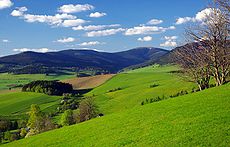 Rolling hills of Králický Sněžník
Rolling hills of Králický Sněžník
At the highest peak of Sněžka (1,602 m/5,256 ft), the average temperature is only −0.4 °C (31.28 °F), whereas in the lowlands of the South Moravian Region, the average temperature is as high as 10 °C (50 °F). The country's capital, Prague, has a similar average temperature, although this is influenced by urban factors.
The coldest month is usually January, followed by February and December. During these months, there is usually snow in the mountains and sometimes in the major cities and lowlands. During March, April and May, the temperature usually increases rapidly, especially during April, when the temperature and weather tends to vary widely during the day. Spring is also characterized by high water levels in the rivers, due to melting snow with occasional flooding.
The warmest month of the year is July, followed by August and June. On average, summer temperatures are about 20 degrees higher than during winter. Especially in the last decade,[citation needed] temperatures above 30 °C (86 °F) are not unusual. Summer is also characterized by rain and storms.
Autumn generally begins in September, which is still relatively warm and dry. During October, temperatures usually fall below 15 °C (59 °F) or 10 °C (50 °F) and deciduous trees begin to shed their leaves. By the end of November, temperatures usually range around the freezing point.
The coldest temperature ever measured was in Litvínovice near České Budějovice, at −42.2 °C (−44.0 °F) and the hottest measured, was at 40.2 °C (104.4 °F) at Praha, Uhříněves.
Economy
Main article: Economy of the Czech Republic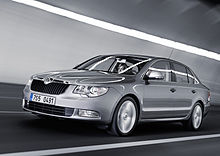 Škoda Auto is one of the largest car manufacturers in Central Europe. In 2010, 762,500 cars were sold worldwide, a record for the company.
Škoda Auto is one of the largest car manufacturers in Central Europe. In 2010, 762,500 cars were sold worldwide, a record for the company.
The Czech Republic possesses a developed,[35] high-income[36] economy with a GDP per capita of 80% of the European Union average.[37] One of the most stable and prosperous of the post-Communist states, the Czech Republic has seen a growth of over 6% annually in the three years before outbreak of the recent global economic crisis. Growth has been led by exports to the European Union, especially Germany and foreign investment, while domestic demand is reviving.
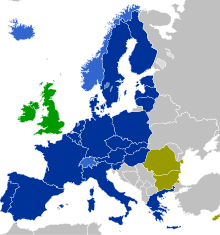 The Czech Republic is part of the EU single market and the Schengen Area.
The Czech Republic is part of the EU single market and the Schengen Area.
Most of the economy has been privatised, including the banks and telecommunications. The current centre-right government plans to continue with privatisation, including the energy industry and the Prague airport. It has recently agreed to the sale of a 7% stake in the energy producer, CEZ Group, with the sale of the Budějovický Budvar brewery also mooted. A 2009 survey in cooperation with the Czech Economic Association found that the majority of Czech economists favor continued liberalization in most sectors of the economy.[38]
The country is part of the Schengen Area, having abolished border controls, completely opening its borders with all of its neighbours, Germany, Austria, Poland and Slovakia, on 21 December 2007.[39] The Czech Republic became a member of the World Trade Organisation.
The last Czech government led by social democrats had expressed a desire to adopt the euro in 2010, but the current centre-right government suspended that plan in 2007.[40] An exact date has not been set up, but the Finance Ministry described adoption by 2012 as realistic,[41] if public finance reform passes. However, the most recent draft of the euro adoption plan omits giving any date. Although the country is economically better positioned than other EU Members to adopt the euro, the change is not expected before 2013, due to political reluctance on the matter.[42]
On 1 January 2009, former Czech PM, Mirek Topolánek, declared that on 1 November 2009, the Czech government will announce a fixed date for euro adoption, since the country "currently fulfils all criteria for adoption of the euro", however his subsequent deposition has rendered this deadline moot.[43] There are several challenges, however. The rate of corruption remains one of the highest among the other developed OECD countries and the public budgets remain in deficit despite strong growth of the economy in recent years. However, the 2007 deficit has been 1.58% GDP and the 2008 deficit is expected at 1.2% GDP,[44] according to EU accounting rules, far better than original projections.
The Programme for International Student Assessment, coordinated by the OECD, currently ranks the Czech education system as the 15th best in the world, higher than the OECD average.[45]
Transportation infrastructure
Main article: Transport in the Czech RepublicRuzyně International Airport in Prague is the main international airport in the country. In 2010, it handled 11.6 million passengers, which makes it the busiest airport in Central and Eastern Europe. In total, Czech Republic has 46 airports with paved runways, six of which provide international air services, in Brno, Karlovy Vary, Mošnov (near Ostrava), Pardubice, Prague and Uherské Hradiště.
České dráhy (the Czech railways) is the main railway operator in the Czech Republic, with about 180 million passengers carried yearly. Its cargo division, ČD Cargo, is the fifth largest railway cargo operator in the European Union.[citation needed] With 9,505 km (5,906.13 mi) of tracks, the Czech Republic has one of the densest railway networks in Europe.[46] From that number, 2,926 km (1,818.13 mi) is electrified, 7,617 km (4,732.98 mi) are single-line tracks and 1,866 km (1,159.48 mi) are double and multiple-line tracks.[47] In 2006 entered service new italian tilting trains Pendolino ČD Class 680, they have reached a speed of 237 km/h and created a new Czech railway speed record.
In 2005, according to the Czech Statistical Office, 65.4% of electricity was produced in steam, combined and combustion power plants (mostly coal); 30% in nuclear plants; and 4.6% from renewable sources, including hydropower. Russia, via pipelines through Ukraine and to a lesser extent, Norway, via pipelines through Germany, supply the Czech Republic with liquid and natural gas.
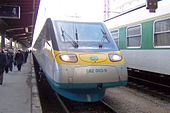 Fast train unit Pendolino in Masarykovo nádraží
Fast train unit Pendolino in Masarykovo nádraží
The Czech Republic is reducing its dependence on highly polluting low-grade brown coal as a source of energy. Nuclear power presently provides about 30% of the total power needs, its share is projected to increase to 40%. Natural gas is procured from Russian Gazprom, roughly three-fourths of domestic consumption and from Norwegian companies, which make up most of the remaining one-fourth. Russian gas is imported via Ukraine (Druzhba pipeline), Norwegian gas is transported through Germany. Gas consumption (approx. 100 TWh in 2003–2005) is almost two times higher than the electricity consumption. South Moravia has small oil and gas deposits.
The road network in the Czech Republic is 55,653 km (34,581.17 mi) long.[48] and 738,4 km of motorways and 439,1 km of expressways.[49] The speed limit is 130 km/h or 80mph.
Communications
Main article: Internet in the Czech RepublicThe Czech Republic has the most Wi-Fi subscribers in the European Union.[50][51] By the beginning of 2008, there was over 800 mostly local WISPs,[52][53] with about 350,000 subscribers in 2007. Mobile internet is very popular. Plans based on either GPRS, EDGE, UMTS or CDMA2000 are being offered by all three mobile phone operators (T-Mobile, Vodafone, Telefonica O2) and internet provider U:fon. Government-owned Český Telecom slowed down broadband penetration. At the beginning of 2004, local-loop unbundling began and alternative operators started to offer ADSL and also SDSL. This and later privatisation of Český Telecom helped drive down prices.
On 1 July 2006, Český Telecom was acquired by globalized company (Spain owned) Telefonica group and adopted new name Telefónica O2 Czech Republic. As of January 2006, ADSL2+ is offered in many variants, both with data limit and without with speeds up to 10 Mbit/s. Cable internet is gaining popularity with its higher download speeds beginning at 2 Mbit/s up to 100 Mbit/s. The largest ISP[citation needed], UPC (which acquired another CATV internet provider Karneval in 2007), provides its service in all major cities.
Science
The Czech Republic has a rich scientific tradition. Important inventions include the modern contact lens, the separation of modern blood types, and the production of the Semtex plastic explosive. Prominent scientists who lived and worked in historically Czech lands include:
- Jan Amos Komenský (1592–1670), educator and national hero, often considered the founder of modern education for his work in pedagogy.[54]
- Václav Prokop Diviš (1698–1765), inventor of the lightning rod; independently of Benjamin Franklin
- Bernard Bolzano (1781–1848), noted mathematician, logician, philosopher, and pacifist.
- Jan Evangelista Purkyně (1787–1869), anatomist and physiologist responsible for the discovery of Purkinje cells, Purkinje fibres and sweat glands, as well as Purkinje images and the Purkinje shift.
- Josef Ressel (1793–1857), inventor of the screw propeller.[54]
- Gregor Mendel (1822–1884), often called the "father of genetics", is famed for his research concerning the inheritance of genetic traits.[54]
- Bedřich Hrozný (1879–1952), deciphered the Hittite language.[54]
- Jaroslav Heyrovský (1890–1967), first Czech Nobel Prize laureate, awarded the prize in 1959 for pioneering research in polarography and electroanalytical chemistry.[54]
- Otto Wichterle (1913–1998) and Drahoslav Lím (1925–2003), Czech chemists responsible for the invention of the modern contact lens.[55]
- Stanislav Brebera (* 1925), inventor of the plastic explosive Semtex.[56]
- Antonín Holý (* 1936), scientist and chemist, in 2009 was involved in the creation of the most effective drug in the treatment of AIDS.[57]
A number of other scientists are also connected in some way with the Czech Lands, including astronomers Johannes Kepler and Tycho Brahe, the founder of the psychoanalytic school of psychiatry Sigmund Freud, physicists Ernst Mach, Albert Einstein, engineer Viktor Kaplan and logician Kurt Gödel.
Tourism
Main article: Tourism in the Czech RepublicThe Czech economy gets a substantial income from tourism. In 2001, the total earnings from tourism reached 118.13 billion CZK, making up 5.5% of GNP and 9.3% of overall export earnings. The industry employs more than 110,000 people – over 1% of the population.[58] In 2008, however, there was a slump in tourist numbers in Prague, possibly due to the strong Czech koruna (crown) making the country too expensive for visitors, compared to the level of services that were available.[59]
The country's reputation has also suffered with guidebooks and tourists reporting overcharging by taxi drivers and pickpocketing problems.[59][60] Since 2005, Prague's mayor, Pavel Bém, has worked to improve this reputation by cracking down on petty crime[60] and, aside from these problems, Prague is a safe city.[61] Also, the Czech Republic as a whole generally has a low crime rate.[62] For tourists, the Czech Republic is considered a safe destination to visit. The low crime rate makes most cities and towns safe to walk around even after dark.
There are several centres of tourist activity. The historic city of Prague is the primary tourist attraction,[citation needed] as the city is also the most common point of entry for tourists visiting other parts of the country.[63] Most other cities in the country attract significant numbers of tourists, but the spa towns, such as Karlovy Vary, Mariánské Lázně and Františkovy Lázně, are particularly popular holiday destinations.[citation needed] Other popular tourist sites are the many castles and chateaux, such as those at Karlštejn Castle, Český Krumlov and the Lednice–Valtice area. Away from the towns, areas such as Český ráj, Šumava and the Krkonoše Mountains attract visitors seeking outdoor pursuits.
The country is also famous for its love of puppetry and marionettes with a number of puppet festivals throughout the country.[citation needed]
The Czech Republic also has a number of beer festivals, including: Czech Beer Festival (the biggest Czech beer festival, it is 17 days long and held every year in May in Prague), Pilsner Fest (every year in August in Plzeň), The "Olomoucký pivní festival" (in Olomouc) or festival "Slavnosti piva v Českých Budějovicích" (in České Budějovice).
Population of the Czech lands[64] Year Total Change 1857 7,016,531 – 1869 7,617,230 +8.6% 1880 8,222,013 +7.9% 1890 8,665,421 +5.4% 1900 9,372,214 +8.2% 1910 10,078,637 +7.5% 1921 10,009,587 −0.7% 1930 10,674,386 +6.6% 1950 8,896,133 −16.7% 1961 9,571,531 +7.6% 1970 9,807,697 +2.5% 1980 10,291,927 +4.9% 1991 10,302,215 +0.1% 2001 10,230,060 −0.7% 2011 10,540,748 +2.9% Demographics
Main article: Demographics of the Czech RepublicAccording to the 2001 census, the vast majority of the inhabitants of the Czech Republic are Czechs (94.24%) (including Moravians and Silesians). The most numerous national minorities are: Slovaks (1.89%); Poles (0.51%); Germans (0.38%); Ukrainians (0.22%); Vietnamese (0.17%); Hungarians (0.14%); Russians (0.12%); Romani (0.11%); Bulgarians (0.04%); and Greeks (0.03%).[65] According to some estimates, there are actually at least 250,000 Romani people in the Czech Republic.[66][67]
There were 436,116 foreigners residing in the country in October 2009, according to the Czech Interior Ministry,[68] with the largest groups being Ukrainian (132,481), Slovak (75,210), Vietnamese (61,102), Russian (29,976), Polish (19,790), German (14,156), Moldovan (10,315), Bulgarian (6,346), Mongolian (5,924), American (5,803), Chinese (5,314), British (4,461), Belarusian (4,441), Serbian (4,098), Romanian (4,021), Kazakh (3,896), Austrian (3,114), Italian (2,580), Dutch (2,553), French (2,356), Croatian (2,351), Bosnian (2,240), Armenian (2,021), Uzbek (1,969), Macedonian (1,787) and Japanese (1,581).[68]
The Jewish population of Bohemia and Moravia, 118,000 according to the 1930 census, was virtually annihilated by the Nazis during the Holocaust.[69] There were approximately 4,000 Jews in the Czech Republic in 2005.[70] The former Czech prime minister, Jan Fischer, is of Jewish origin and faith.[71]
The fertility rate is a low 1.50 children per woman.Immigration increased the population by almost 1% in 2007. About 77,000 new foreigners settle down in the Czech Republic every year.[72] Vietnamese immigrants began settling in the Czech Republic during the Communist period, when they were invited as guest workers by the Czechoslovak government.[73] Today, there are an estimated 70,000 Vietnamese in the Czech Republic.[74] In contrast to Ukrainians, Vietnamese come to the Czech Republic to live permanently.[75]
At the turn of the 20th century, Chicago was the city with the third largest Czech population,[76] after Prague and Vienna.[77] According to the 2006 US census, there are 1,637,218 Americans of full or partial Czech descent.[78]
Rank City Region Population Metropolitan area 1 Prague Prague, the Capital City 1,300,108 
2,300,000 2 Brno South Moravian 450,820 
810,000[79] 3 Ostrava Moravian-Silesian 321,026 
1,164,328 4 Plzeň Plzeň 177,127 
380,000 5 Liberec Liberec 104,964 
270,000 6 Olomouc Olomouc 101,785 
480,000[80] 7 Ústí nad Labem Ústí nad Labem 100,504 - 8 České Budějovice South Bohemian 100,043 - 9 Hradec Králové Hradec Králové 95,485 - 10 Pardubice Pardubice 94,725 - 11 Havířov Moravian-Silesian 83,083 - 12 Zlín Zlín 80,866 450 000 13 Kladno Central Bohemian 74,721 - 14 Most Ústí nad Labem 68,967 - 15 Karviná Moravian-Silesian 64,614 - 16 Opava Moravian-Silesian 61,525 - 17 Frýdek-Místek Moravian-Silesian 59,264 - 18 Karlovy Vary Karlovy Vary 55,219 - 19 Děčín Ústí nad Labem 51,878 - 20 Jihlava Vysočina 51,160 - Top religious affiliations in the Czech Republic, census 1991–2001[81] 1991 2001 change number % number % no religion 4,112,864 39.9 6,039,991 59.0 +46.9% Roman Catholic Church 4,021,385 39.0 2,740,780 26.8 −31.8% not identified 1,665,617 16.2 901,981 8.8 −45.8% Evangelical Church of Czech Brethren 203,996 2.0 117,212 1.1 −42.5% Czechoslovak Hussite Church 178,036 1.7 99,103 1.0 −44.3% total population 10,302,215 100.0 10,230,060 100.0 −0.7% Religion
The Czech Republic has one of the least religious populations on Earth. Historically, the Czech people have been characterised as "tolerant and even indifferent towards religion".[82] According to the 2001 census, 59% of the country is agnostic, atheist or irreligious, 26.8% is Roman Catholic and 2.5% is Protestant.[83] From 1991 to 2001, the number of people identifying with no religion increased by 19.1%, or two million people, representing the largest group increase. Adherence to Christianity decreased by over one million persons.
According to a Eurobarometer Poll in 2005,[84] 19% of Czech citizens responded that "they believe there is a God" (the second lowest rate among European Union countries after Estonia with 16%),[85] whereas 50% answered that "they believe there is some sort of spirit or life force" and 30% said that "they do not believe there is any sort of spirit, God or life force".
Culture
Main article: Culture of the Czech RepublicMusic
Main article: Music of the Czech RepublicMusic in the Czech Republic has its roots in more than 1000 years old sacred music (first preserved references come from the end of 10th century), in traditional folk music of Bohemia, Moravia and Silesia and in long-term high-culture classical music tradition. Since early eras of artificial music, Czech musicians and composers have been often influenced by genuine folk music. Notable Czech composers include Adam Michna, Jan Dismas Zelenka, Josef Mysliveček, Bedřich Smetana, Leoš Janáček, Antonín Dvořák, Bohuslav Martinů, Erwin Schulhoff and Petr Eben. The most famous music festival is "Prague Spring" (Pražské jaro),[citation needed] that has been annually organized since 1946.
Literature
Main article: Czech literatureCzech literature is the literature written by Czechs or other inhabitants of the Czech state, mostly in the Czech language, although other languages like Old Church Slavonic, Latin or German have been also used, especially in the past. Czech authors who had written in the German language, such as Franz Kafka, are usually excluded from the corpus of Czech literature, regardless of their own national self-identification.[citation needed]
Czech literature is divided into several main time periods: the Middle Ages; the Hussite period; the years of re-Catholicization and the baroque; the Enlightenment and Czech reawakening in the 19th century; the avantgarde of the interwar period; the years under Communism and the Prague Spring; and the literature of the post-Communist Czech Republic. Czech literature and culture played a major role on at least two occasions, when Czechs lived under oppression and political activity was suppressed. On both of these occasions, in the early 19th century and then again in the 1960s, the Czechs used their cultural and literary effort to strive for political freedom, establishing a confident, politically aware nation.[citation needed]
Theatre
Main article: Theatre of the Czech RepublicTheatre of the Czech Republic has rich tradition with roots in the Middle Ages. In the 19th century, the theatre played an important role in the national awakening movement and later, in the 20th century it became a part of the modern European theatre art.
Cuisine
Main article: Czech cuisineCzech cuisine is marked by a strong emphasis on meat dishes. Pork is quite common; beef and chicken are also popular. Goose, duck, rabbit and wild game are served. Fish is rare, with the occasional exception of fresh trout and carp, which is served at Christmas.
Czech beer has a long and important history. The first brewery is known to have existed in 1118 and Czech Republic has the highest beer consumption per capita in the world. The famous Pilsener style beer originated in western Bohemian city of Plzeň, and further south the town of Budweis lent its name to its beer, eventually known as Budweiser Bier Bürgerbräu thus Budweiser Budvar. The tourism is slowly sparkling around the Southern Moravian region too, which is producing wine since Middle Ages, about 94% of vineyards in Czech Republic are Moravian. Aside from Slivovitz, Czech beer and wine, Czechs also produce two uniquely Czech liquors, Fernet Stock and Becherovka. Kofola is a non-alcoholic domestic cola soft drink which competes with Coca Cola and Pepsi in popularity.
Two unique Czech dishes are vepřo-knedlo-zelo and svíčková na smetaně. Czech desserts aren't particularly sweet, and frequently are with poppy seeds.
Sports
See also: Sport in the Czech Republic, Czech Republic men's national ice hockey team, and Czech Republic national football teamSports play a part in the life of many Czechs, who are generally loyal supporters of their favourite teams or individuals. The two leading sports in the Czech Republic are football (soccer) and ice hockey, both drawing the largest attention of both the media and supporters. Tennis is also a very big sport in the Czech Republic. The many other sports with professional leagues and structures include basketball, volleyball, team handball, track and field athletics and floorball. The Czech ice hockey team won the gold medal at the 1998 Winter Olympics and won three straight gold medals at the world championships from 1999 to 2001 and at the 1996, 2005 and 2010 tournaments. In total achieved 59 in summer and 7 in winter gold medals in all-time Olympic Games history (ČR+Czechoslovakia).
Sport is a source of strong waves of patriotism, usually rising several days or weeks before an event.[citation needed] The events considered the most important by Czech fans[citation needed] are: the Ice Hockey World Championships, Olympic Ice hockey tournament, UEFA European Football Championship, FIFA World Cup and qualification matches for such events. In general, any international match of the Czech ice hockey or football national team draws attention, especially when played against a traditional rival:[citation needed] Germany and Netherlands in football; Russia, Finland, Sweden, United States, and Canada in ice hockey; and Slovakia in both. Matches against Germany and Russia possess an additional element of rivalry due to historically political friction,[citation needed] while matches against Slovakia are in large part considered significant[citation needed] because the two countries had been united prior to their separation from each other in the 1993. The Czech Republic also has great influence on tennis with such players as,Ivan Lendl, 8 times Grand Slam singles champion, 2010 Wimbledon Championships - Men's Singles finalist Tomáš Berdych, 2011 Wimbledon Championships - Women's Singles champion, Petra Kvitova, 1998 Wimbledon Women's Singles title Jana Novotná, 2011 Wimbledon Championships – Women's Doubles champion Květa Peschke and 18 time Grand Slam Champion Martina Navratilova.
-
Prague Astronomical Clock is the oldest working astronomical clock in the world
-
Karlštejn Castle in the Central Bohemian Region, founded in 1348 by Charles IV
-
Mariánské Lázně, a spa town in the Karlovy Vary Region
-
Royal castle in Hluboká nad Vltavou, built in the 13th century
-
Jaromír Jágr is the leading point scorer among active NHL players[86]
-
Chateau in Lednice, a village containing a palace and the largest park in the country
-
Český Šternberk is an early gothic castle from the mid 13th century
-
The Ski resort at Šumava, attractive snowpark with 3 four-chair lifts.
-
The precious Czech Crown Jewels are the fourth oldest in Europe
See also
- Outline of the Czech Republic
- Index of Czech Republic-related articles
 Czech Republic
Czech RepublicHistory Geography RiversGovernance Politics Economy Society Culture Symbols Flag · Coat of arms
 Category ·
Category ·  Portal ·
Portal ·  WikiProject
WikiProjectReferences
- ^ Slovak language is defined as official language together with Czech language by several laws – e.g. law 500/2004, 337/1992. Source: http://portal.gov.cz. Cited: "Například Správní řád (zákon č. 500/2004 Sb.) stanovuje: "V řízení se jedná a písemnosti se vyhotovují v českém jazyce. Účastníci řízení mohou jednat a písemnosti mohou být předkládány i v jazyce slovenském..." (§16, odstavec 1). Zákon o správě daní a poplatků (337/1992 Sb.) „Úřední jazyk: Před správcem daně se jedná v jazyce českém nebo slovenském. Veškerá písemná podání se předkládají v češtině nebo slovenštině..." (§ 3, odstavec 1). http://portal.gov.cz
- ^ Citizens belonging to minorities, which traditionally and on long-term basis live within the territory of the Czech Republic, enjoy the right to use their language in communication with authorities and in front of the courts of law (for the list of recognized minorities see National Minorities Policy of the Government of the Czech Republic). The article 25 of the Czech Charter of Fundamental Rights and Basic Freedoms ensures right of the national and ethnic minorities for education and communication with authorities in their own language. Act No. 500/2004 Coll. (The Administrative Rule) in its paragraph 16 (4) (Procedural Language) ensures, that a citizen of the Czech Republic, who belongs to a national or an ethnic minority, which traditionally and on long-term basis lives within the territory of the Czech Republic, have right to address an administrative agency and proceed before it in the language of the minority. In case that the administrative agency doesn't have an employee with knowledge of the language, the agency is bound to obtain a translator at the agency's own expense. According to Act No. 273/2001 (About The Rights of Members of Minorities) paragraph 9 (The right to use language of a national minority in dealing with authorities and in front of the courts of law) the same applies for the members of national minorities also in front of the courts of law.
- ^ CIA – The World Factbook – Czech Republic
- ^ Czech Statistical Office estimated czech population on March 31st 2011 (cited June 20th 2011)
- ^ a b "Czech Republic". International Monetary Fund. http://www.imf.org/external/pubs/ft/weo/2011/01/weodata/weorept.aspx?pr.x=51&pr.y=11&sy=2008&ey=2011&scsm=1&ssd=1&sort=country&ds=.&br=1&c=935&s=NGDPD%2CNGDPDPC%2CPPPGDP%2CPPPPC%2CLP&grp=0&a=. Retrieved 21 April 2011.
- ^ "Human Development Report 2010". United Nations. 2010. http://hdr.undp.org/en/media/HDR_2010_EN_Table1.pdf. Retrieved 5 November 2010.
- ^ Oxford English Dictionary, second edition, Oxford University Press, 1989.
- ^ a b Velinger, Jan (28 February 2006). "World Bank Marks Czech Republic's Graduation to 'Developed' Status". Radio Prague. http://www.radio.cz/en/article/76314. Retrieved 22 January 2007.
- ^ a b "UNDP.org" (PDF). http://hdr.undp.org/en/media/HDR_2009_EN_Complete.pdf. Retrieved 25 April 2010.
- ^ Global Peace Index
- ^ Democracy Index
- ^ List of countries by infant mortality rate
- ^ "Oxford English Dictionary". Askoxford.com. http://oxforddictionaries.com/view/entry/m_en_gb0201690#m_en_gb0201690. Retrieved 4 March 2011.
- ^ "The Annals of Jan Dlugosz". Impub.co.uk. http://www.impub.co.uk/dlug3.html. Retrieved 25 April 2010.
- ^ "The rise and fall of the Przemyslid Dynasty". Archiv.radio.cz. http://archiv.radio.cz/history/history03.html. Retrieved 25 April 2010.
- ^ "Václav II. český král". http://www.panovnici.cz/vaclav-II-kral.
- ^ Emperor Charles IV elected Greatest Czech of all time, Radio Prague
- ^ "The flowering and the decline of the Czech medieval state". Arts.gla.ac.uk. http://www.arts.gla.ac.uk/Slavonic/Czech_Hist4.html. Retrieved 25 April 2010.
- ^ "Plague epidemics in Czech countries". E. Strouhal. p.49.
- ^ Oskar Krejčí, Martin C. Styan, Ústav politických vied SAV. (2005). Geopolitics of the Central European region: the view from Prague and Bratislava. p.293. ISBN 8022408522
- ^ "RP's History Online – Habsburgs". Archiv.radio.cz. http://archiv.radio.cz/history_96/history07.html. Retrieved 25 April 2010.
- ^ "History of the Mongols from the 9th to the 19th Century. Part 2. The So-Called Tartars of Russia and Central Asia. Division 1". Henry Hoyle Howorth. p.557. ISBN 1402177720
- ^ "The new Cambridge modern history: The ascendancy of France, 1648–88". Francis Ludwig Carsten (1979). p.494. ISBN 0521045444
- ^ "The Cambridge economic history of Europe: The economic organization of early modern Europe". E. E. Rich, C. H. Wilson, M. M. Postan (1977). p.614. ISBN 0521087104
- ^ Radio Praha – zprávy (Czech)
- ^ "Tab. 3 Národnost československých státních příslušníků podle žup a zemí k 15.2.1921" (in Czech) (PDF). Czech Statistical Office. Archived from the original on 5 June 2007. http://web.archive.org/web/20070605105429/http://www.czso.cz/sldb/sldb.nsf/i/8BE4678613181F2AC1256E66004C77DD/$File/tab3_21.pdf. Retrieved 2 June 2007.
- ^ Gerhard L. Weinberg, The Foreign Policy of Hitler's Germany: Starting World War II, 1937–1939 (Chicago, 1980), pp. 470–481.
- ^ Stephen A. Garrett (1996). "Conscience and power: an examination of dirty hands and political leadership". Palgrave Macmillan. p.60. ISBN 0312159080
- ^ "A Companion to Russian History". Abbott Gleason (2009). Wiley-Blackwell. p.409. ISBN 1-4051-3560-3
- ^ Libri.cz (Czech)
- ^ Czech schools revisit communism. BBC News. 1 November 2005.
- ^ "Czechs with few mates". The Economist. 30 August 2007. http://www.economist.com/displayStory.cfm?story_id=9725352. Retrieved 25 April 2010.
- ^ The death of the districts, Radio Prague 3 January 2003.
- ^ R. Tolasz, Climate Atlas of Czechia, Czech Hydrometeorological Institute, Prague, 2007. 254pp. Hardback ISBN 978-80-86690-1
- ^ Getting to know Czech Republic, from Czech.cz, the official site of the Czech Republic
- ^ "World Bank 2007". Web.worldbank.org. http://web.worldbank.org/WBSITE/EXTERNAL/DATASTATISTICS/0,,contentMDK:20421402~pagePK:64133150~piPK:64133175~theSitePK:239419,00.html#High_income. Retrieved 25 April 2010.
- ^ "GDP per capita in PPS". Eurostat. http://epp.eurostat.ec.europa.eu/cache/ITY_PUBLIC/2-25062009-BP/EN/2-25062009-BP-EN.PDF. Retrieved 25 June 2009.
- ^ Stastny, Daniel. "Czech Economists on Economic Policy: A Survey", Econ Journal Watch 7[3]: 275–287, Sept 2010.[1]
- ^ "Czech Republic to join Schengen". The Prague Post. 13 December 2006. Archived from the original on 25 February 2008. http://web.archive.org/web/20080225173344/http://www.praguepost.com/articles/2006/12/13/czech-republic-to-join-schengen.php. Retrieved 8 October 2007.
- ^ "Finance Ministry backtracks on joining the Euro by 2012". Radio Praha. http://www.radio.cz/en/news/94849. Retrieved 22 December 2008.
- ^ "Czech government adopts euro adoption plan". EUbusiness. 11 April 2007. Archived from the original on 30 September 2007. http://web.archive.org/web/20070930165055/http://www.eubusiness.com/Euro/czech-euro.83/. Retrieved 1 June 2007.
- ^ "Euros in the wallets of the Slovaks, but who will be next?" (Press release). Sparkasse.at. 5 August 2008. https://www.sparkasse.at/sPortal/sportal.portal;jsessionid=qhHSJ0FRvFSBNdNpZkKJVhvhHLJD4v1T2d1BG3Gcyj82vJYTDKm3!76983841?_nfpb=true&_windowLabel=LABEL_MAIN&_urlType=action&LABEL_MAIN_sh=181fe8bb390eeff395532e7956f3e368&LABEL_MAIN_action=content.main&LABEL_MAIN_OVERRULEREFRESHBACK=true&LABEL_MAIN_event=changeMain&LABEL_MAIN_chronicleId=%2Febgroup_en_0196%2FChannels%2FPress%2F2008%2F2.QU%2Feb_pi_en_20080508_next_main_Images.akp&LABEL_MAIN_zz=41235.36447435065&LABEL_MAIN_pc=1&_pageLabel=GRID02&cci=09002ee2805dab70&desk=ebgroup_en_0196&navigationId=012130649753268001119092&. Retrieved 21 December 2008.
- ^ "Czech PM: On Nov 1 Govt Will Set Euro Adoption Date". http://www.fxstreet.com/news/forex-news/article.aspx?StoryId=82909ae5-94b8-4124-8dcf-d9a1203ea4fb. Retrieved 1 January 2009.
- ^ "Czech 2008 budget gap much lower than expected". Forbes. 1 January 2009. http://www.forbes.com/afxnewslimited/feeds/afx/2009/01/01/afx5872811.html. Retrieved 1 February 2009.
- ^ "OECD.org" (PDF). http://www.oecd.org/dataoecd/42/8/39700724.pdf. Retrieved 25 April 2010.
- ^ "Transport infrastructure at regional level – Statistics explained". Epp.eurostat.ec.europa.eu. http://epp.eurostat.ec.europa.eu/statistics_explained/index.php/Transport_infrastructure_at_regional_level#Railways. Retrieved 25 April 2010.
- ^ "SZDC.cz". http://provoz.szdc.cz/portal/Show.aspx?oid=185802. Retrieved 9 November 2010.
- ^ (Czech) RSD.cz
- ^ http://www.rsd.cz/sdb_intranet/sdb/download/prehledy_2011_1_cr.pdf
- ^ 2007 WiFi survey EN[dead link]
- ^ "Openspectrum.info – Czech Republic". Volweb.cz. http://www.volweb.cz/horvitz/os-info/czech.html. Retrieved 25 April 2010.
- ^ "Wi-Fi: Poskytovatelé bezdrátového připojení". internetprovsechny.cz. http://translate.google.com/translate?u=http%3A%2F%2Fwww.internetprovsechny.cz%2Fwifi-poskytovatele.php&hl=cs&ie=UTF8&sl=cs&tl=en. Retrieved 17 March 2008.
- ^ "Bezdrátové připojení k internetu". bezdratovepripojeni.cz. http://translate.google.com/translate?u=http%3A%2F%2Fwww.bezdratovepripojeni.cz&hl=cs&ie=UTF8&sl=cs&tl=en. Retrieved 18 May 2008.
- ^ a b c d e Czech.cz – Ingenious inventions. Retrieved 3 March 2009.[dead link]
- ^ The History of Contact Lenses. Retrieved 3 March 2009.
- ^ "Velikáni české vědy". http://www.velikani-ceske-vedy.estranky.cz/clanky/biografie/stanislav-brebera. Retrieved 2010-11-01.
- ^ "Faces of the Presidency". EU2009.cz. http://www.eu2009.cz/en/czech-presidency/presidency-faces/faces-of-the-presidency-3642/. Retrieved 8 January 2009.
- ^ "Promotion Strategy of the Czech Republic in 2004–2010". Czech Tourism. Archived from the original on 28 March 2007. http://web.archive.org/web/20070328141615/http://www.czechtourism.com/index.php?show=001006&lang=3. Retrieved 19 December 2006.
- ^ a b 20:36 UTC (21 April 2010). "Prague sees significant dip in tourist numbers". Radio.cz. http://www.radio.cz/en/article/106877. Retrieved 25 April 2010.
- ^ a b Prague mayor goes undercover to expose the great taxi rip-off, 15 January 2005
- ^ Tips on Staying Safe in Prague, myczechrepublic.com
- ^ Czech Republic – Country Specific Information, U.S. Department of State
- ^ "Czech sights". Discover Czech. http://www.discoverczech.com/czech-sights.php4. Retrieved 19 December 2006.
- ^ "Czech Statistic Office" (in (Czech)). Czso.cz. http://www.czso.cz/eng/redakce.nsf/i/population_hd. Retrieved 25 April 2010.
- ^ "Zjišťování národnosti ve sčítání lidu, domů a bytů v období 1921–2001" (in Czech) (PDF). Czech Statistical Office. p. 2. http://www.czso.cz/csu/2003edicniplan.nsf/t/C2002D382C/$File/Kapitola1.pdf. Retrieved 24 May 2007.
- ^ "The History and Origin of the Roma". Romove.radio.cz. http://romove.radio.cz/en/article/18158. Retrieved 25 April 2010.
- ^ Green, Peter S. (5 August 2001). "British Immigration Aides Accused of Bias by Gypsies". New York Times. http://query.nytimes.com/gst/fullpage.html?res=9401E6DA103CF936A3575BC0A9679C8B63&sec=&spon=&pagewanted=all. Retrieved 25 April 2010.
- ^ a b Foreigners by type of residence, sex and citizenship, Czech Statistical Office, 31 October 2009
- ^ "The Holocaust in Bohemia and Moravia". Ushmm.org. http://www.ushmm.org/wlc/article.php?lang=en&ModuleId=10007323. Retrieved 25 April 2010.
- ^ The Virtual Jewish Library – Jewish population of Czech republic, 2005
- ^ "PM Fischer visits Israel". Radio Prague. 22 July 2009.
- ^ "Press: Number of foreigners in ČR up ten times since 1989". Prague Monitor. 11 November 2009.
- ^ O'Connor, Coilin (29 May 2007). "Is the Czech Republic's Vietnamese community finally starting to feel at home?". Czech Radio. http://www.radio.cz/en/article/91826. Retrieved 1 February 2008.
- ^ Crisis Strands Vietnamese Workers in a Czech Limbo. The New York Times. 5 June 2009.
- ^ "Foreigners working in the Czech Republic". Ministry of Foreign Affairs. July 2006.
- ^ Czechs and Bohemians. Encyclopedia of Chicago.
- ^ Czech and Slovak roots in Vienna. Wieninternational.at
- ^ "U.S. Census". U.S. Census Bureau. http://factfinder.census.gov/servlet/ADPTable?_bm=y&-geo_id=01000US&-ds_name=ACS_2006_EST_G00_&-_lang=en&-_caller=geoselect&-format=. Retrieved 13 April 2008.
- ^ Nařízení vlády č. 105/1994 Sb., kterým se vyhlašuje závazná část územního plánu velkého územního celku Brněnské sídelní regionální aglomerace
- ^ Nařízení vlády č. 212/1997, kterým se vyhlašuje závazná část územního plánu velkého územního celku Olomoucké aglomerace
- ^ "Population by denomination and sex: as measured by 1921, 1930, 1950, 1991 and 2001 censuses" (in Czech and English). Czech Statistical Office. http://www.czso.cz/csu/2008edicniplan.nsf/engt/24003E05ED/$File/4032080119.pdf. Retrieved 9 March 2010.
- ^ Richard Felix Staar, Communist regimes in Eastern Europe, Issue 269, p. 90
- ^ "Obyvatelstvo hlásící se k jednotlivým církvím a náboženským společnostem" (in Czech). Czech Statistical Office. http://www.czso.cz/csu/2003edicniplan.nsf/o/4110-03--obyvatelstvo_hlasici_se_k_jednotlivym_cirkvim_a_nabozenskym_spolecnostem. Retrieved 19 December 2006.
- ^ "Eurobarometer on Social Values, Science and technology 2005 – page 11" (PDF). http://ec.europa.eu/public_opinion/archives/ebs/ebs_225_report_en.pdf. Retrieved 5 May 2007.
- ^ "Social values, Science and Technology" (PDF). Eurobarometer. June 2005. http://ec.europa.eu/public_opinion/archives/ebs/ebs_225_report_en.pdf. Retrieved 19 December 2006.
- ^ Jagr Scores 1,600th Point in Return - The New York Times
Further reading
- Hochman, Jiří. Historical dictionary of the Czech State (1998)
External links
- Government
- Governmental website.
- Presidential website.
- Portal of the Public Administration.
- Chamber of Deputies.
- Senate.
- Chief of State and Cabinet Members.
- General information
- Czech Republic entry at The World Factbook
- Czech Republic information from the United States Department of State.
- Portals to the World from the United States Library of Congress.
- Czech Republic at UCB Libraries GovPubs.
- Czech Republic at the Open Directory Project
Wikimedia Atlas of the Czech Republic
- News
- Statistics
- Travel
- Czech Tourism Official travel site of the Czech Republic.
- Czech Republic travel guide from Wikitravel
Categories:- Czech Republic
- European countries
- Landlocked countries
- Liberal democracies
- Member states of NATO
- Member states of the European Union
- Republics
- Slavic countries
- States and territories established in 1993
- Member states of the United Nations
Wikimedia Foundation. 2010.

![Location of Czech Republic (dark green)– in Europe (green & dark grey)– in the European Union (green) — [Legend]](/pictures/enwiki/50/250px-EU-Czechia.svg.png)
